Successful football teams often have reoccurring patterns—scoring plenty of goals and having a strong defensive foundation are two key factors.
However, particularly outside of the top division in England, it is challenging to tick both of those boxes, as Barrow AFC are finding out so far this season in the 2023/24 EFL League Two season.
After 16 games played at the time of writing, the Bluebirds sit in eighth position, just outside the playoff zone.
Barrow AFC are seemingly a club on the up at the moment under Pete Wild’s tactics – they finished ninth last season after surviving relegation by the skin of their teeth back in 2021/22 and 2020/21, and they have brought last season’s momentum with them this time around.
Currently unbeaten in their previous six League Two games, they are really making a case for themselves as black horse playoff contenders.
Their biggest asset this campaign has been their defensive resilience.
They are tough to break down and show good tactical consistency in their defending.
This scout report will explore the data and match footage behind their defensive ability
.The analysis will also take a brief look into their attacking play and why they have struggled to find form in front of the goal despite showing promise during the build-up.
Use of a mid-block
Suppose there is one thing that manager Pete Wild’s style of play deserves credit for.
In that case, it is the level of tactical discipline we see from his side out of possession—something that can be more difficult to instil with consistency and success the further down the footballing pyramid you get.
Wild’s Barrow strikes a nice balance in the face of opposition possession—not sitting deep but also not applying a high press.
This segment of the tactical analysis
will examine their application of a mid-block, focusing on the activity of the midfielders and forwards during these times.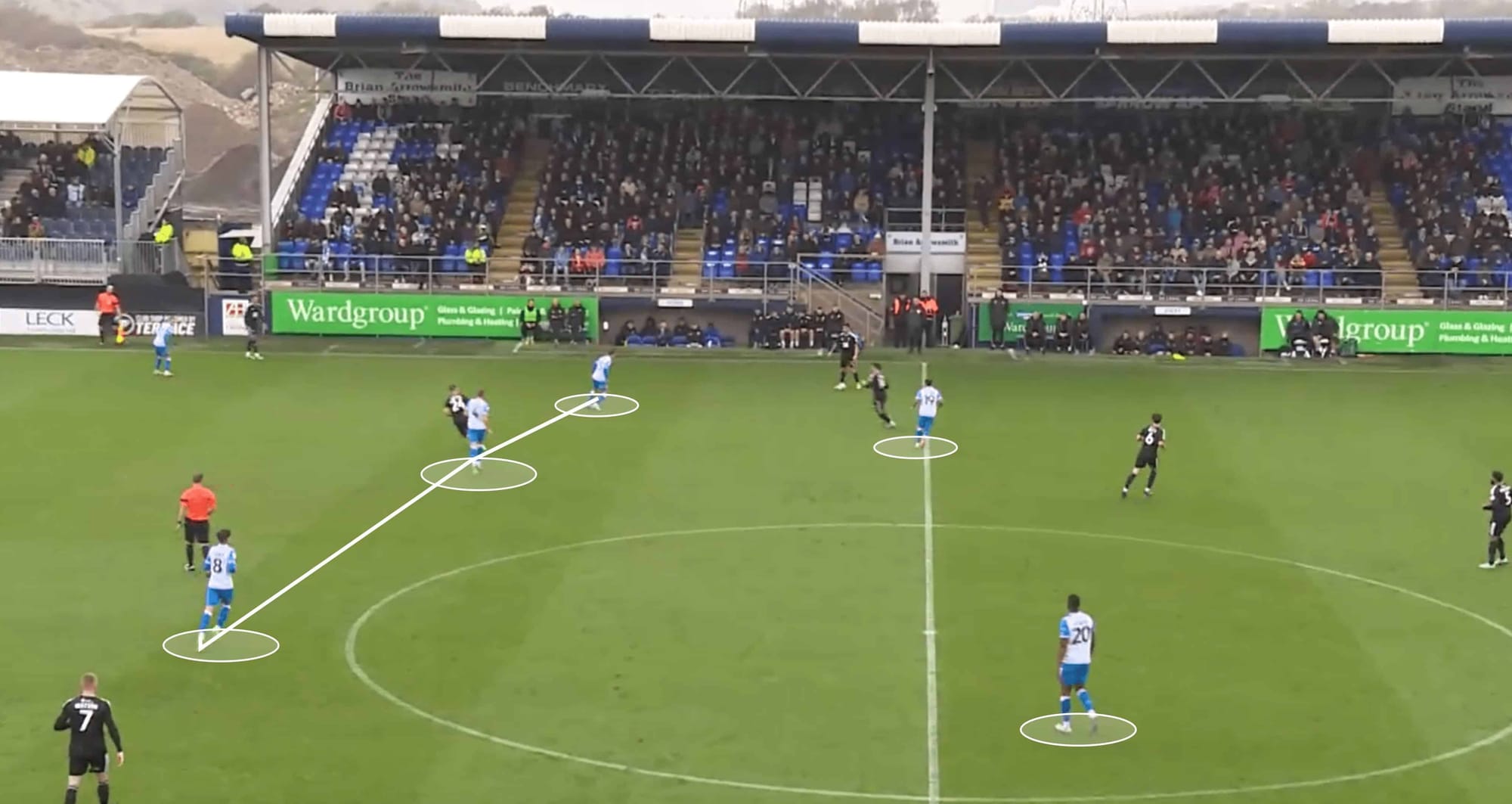
While their use of a mid-block is often well-executed, it is not groundbreaking—and that is not a negative thing! What you see when analysing Barrow’s mid-block is tactical familiarity from the three units, especially the midfielders.
Barrow often deploys a 5-3-2, which sometimes becomes a 3-5-2, but either way, the mechanics behind the midfield three remain basically the same.
The three of them like to cover enough ground to present a challenge to the opposition in terms of pitch width, but they also maintain a certain level of compactness for the apparent reason of not wanting to be carved open easily.
Their distance between the front two is also noteworthy – not sitting too deep and sitting close to the attacking unit gives the opposition less space to work in.
Teams often like to utilise space between the midfield and attacking units as they build attacks, but this approach makes that more difficult.
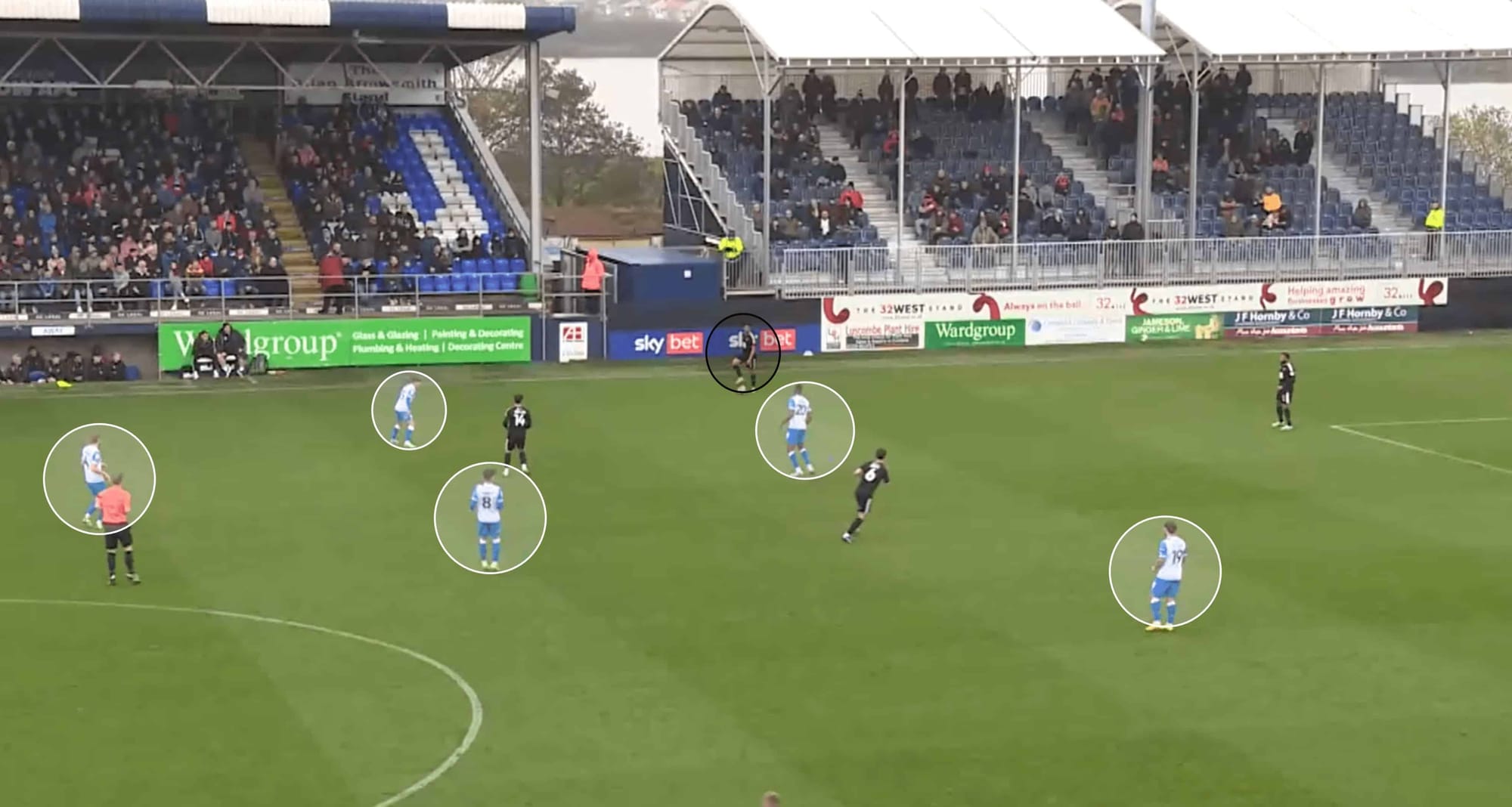
Despite not being a high-intensity pressing side, Barrow does utilise a few pressing triggers.
When the opposition slows its approach down and goes backwards, Barrow responds by pushing up as one whole unit, squeezing the opposition.
They respond in a similar way when the opponent has deep possession but doesn’t move it forward quickly.
Even then, the midfield unit and attacking unit look to remain close together to avoid being played through if the opponent beats the press.
The main activity in these areas comes from midfield, which becomes narrower (if the possession shifts to the opposition full-back) and looks to hassle the opponent more.
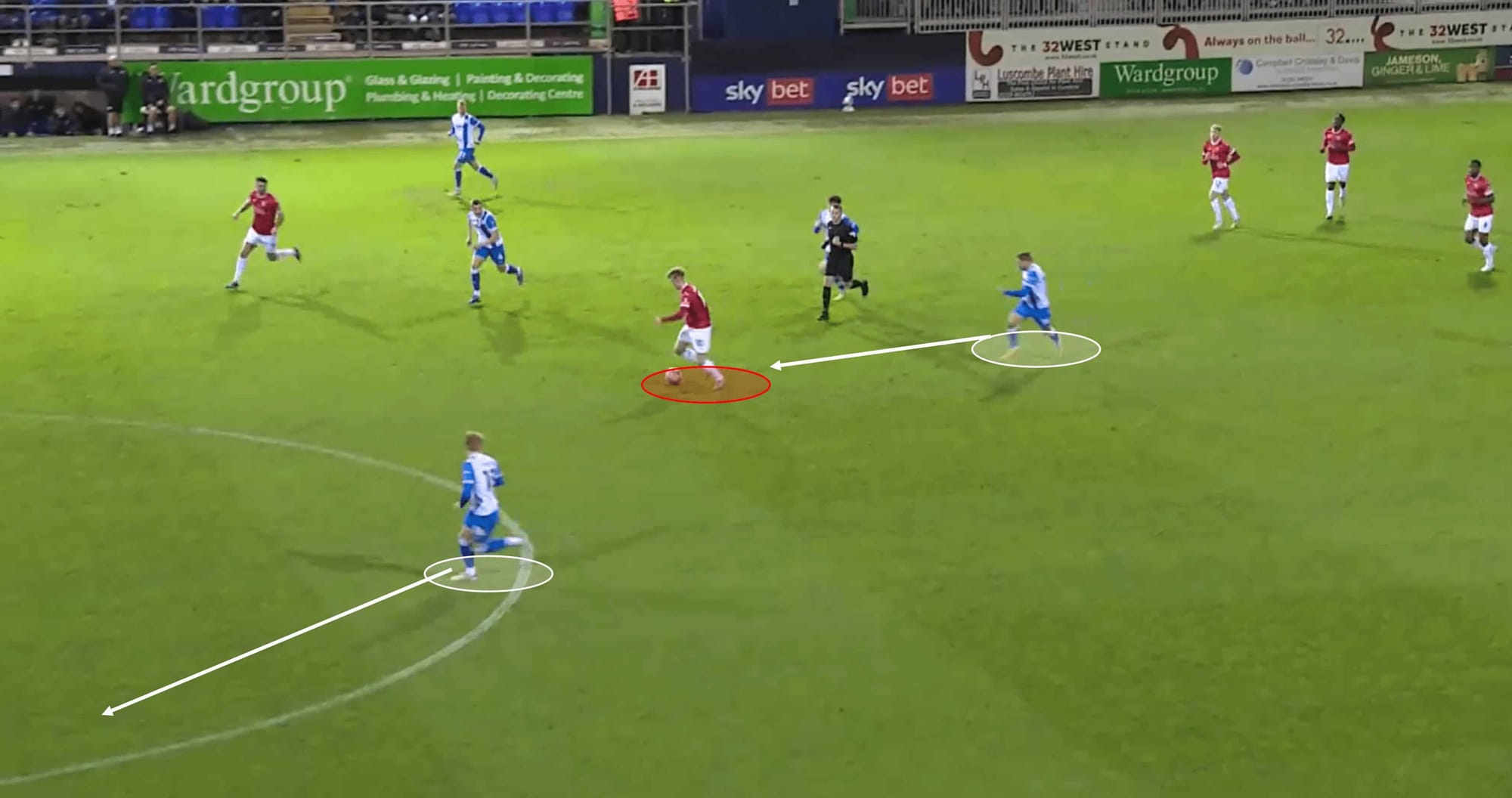
As at any level of football, pushing higher up the pitch comes with risk and could leave you exposed to a counterattack.
Reacting quickly in these moments is a crucial trait, and Barrow seems to tick that box on an individual level.
Players show good awareness and know-how about where they need to be and how to stop the attack.
A 5-3-2 can help defend transitions, depending on how attacking the team is.
Barrow are rarely caught out with too many players forward due to their cautious nature on the ball, but their midfield usually has at least one player sprinting back to meet the opponent on the ball, with other players (right wing-back in the example above) moving into a defensive position where they can be of more assistance if the counterattack does progress.
Unit strength when defending deep
Barrow’s 5-3-2 shape lends itself to a solid defensive base, primarily when they’re tasked with dropping deeper to defend the box/final third.
For any team with a rest defence that isn’t usually deep, making a smooth transition into a deeper setup is crucial – Barrow’s actions in these moments are a significant factor in their impressive defensive record to date.
Here, we look at the tactics involved in Barrow’s defensive approach when required to defend in their own final third.
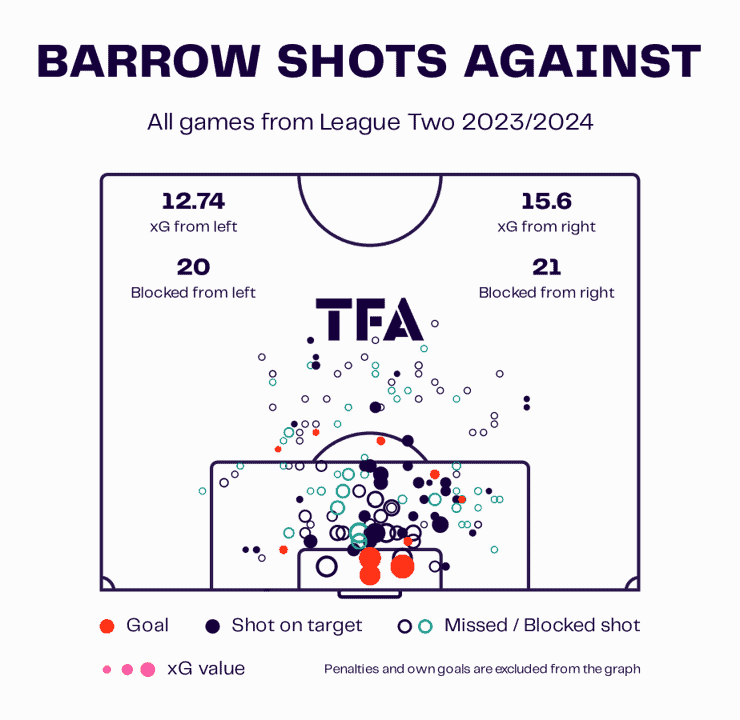
The image above gives us a deeper look at where Barrow
concedes chances.Having conceded just 0.78 goals per 90 so far this season (the second-best defensive record), they are clearly doing something right when it matters.
We can see that they face a lot of long-range efforts, which is a testament to how difficult they make it for other teams in terms of chance creation.
This is why they have the sixth-lowest xGA in League Two (21.31).
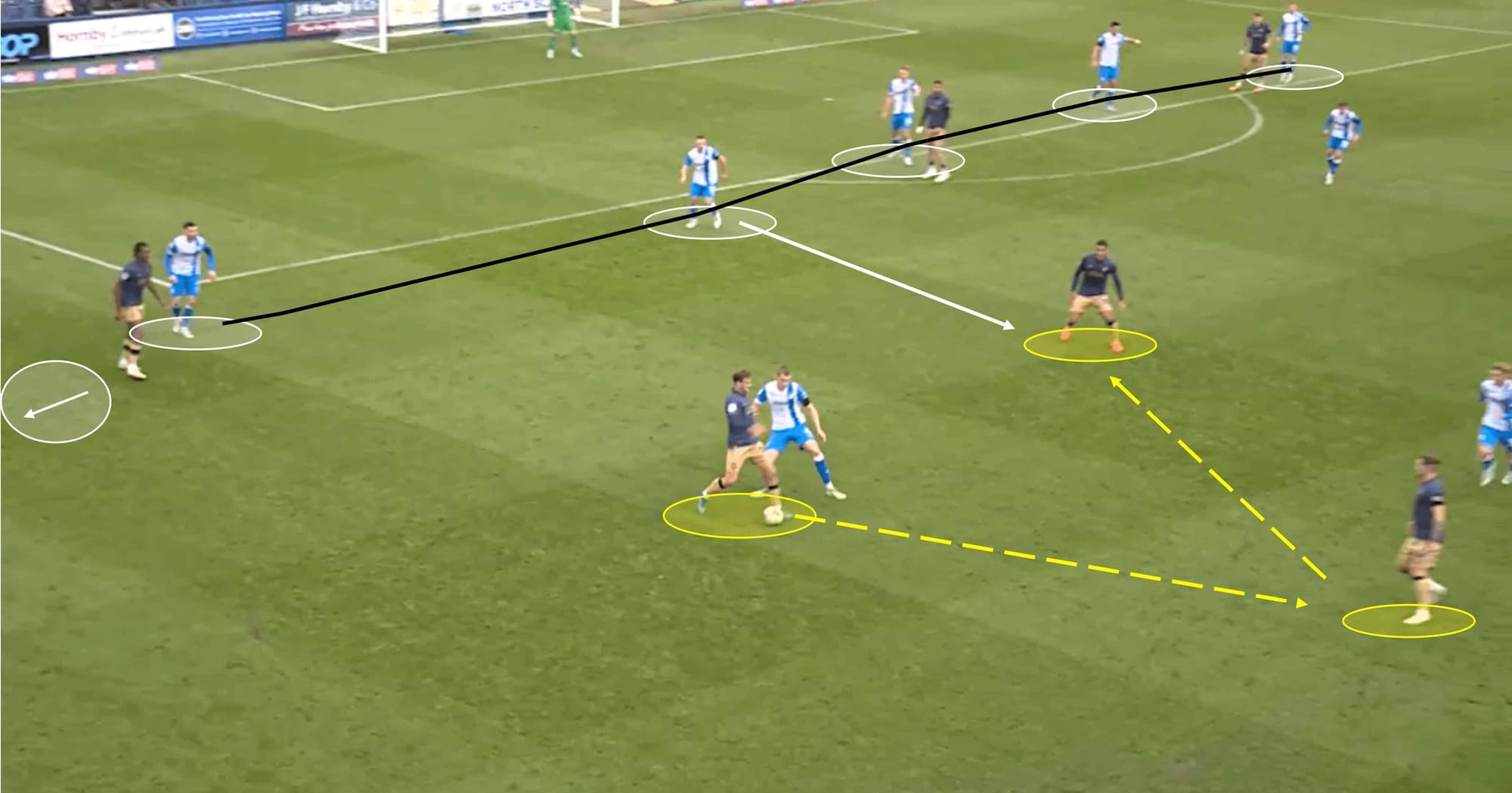
We spoke of Barrow’s ability to react in transitions earlier, and they also respond well, generally in a defensive manner.
Above, you can get a clear view of how their back five lines up when the opposition has progressed their possession, with the (out of shot) midfielder joining the back five in a wide position.
While often well-disciplined, their midfield sometimes becomes disjointed/disorganised due to their sheer workload in and out of possession, but good reactions from elsewhere come into play.
In the analysis above, for example, the opposition has the Barrow midfield outnumbered with a clear view to get past the unit, and the midfielder furthest forward receives the ball.
However, before he can even think about his following action, a Barrow CB bursts out of his defensive line to act as a momentary defensive midfielder and put the opponent under pressure.
This move can either slow the attack down, allowing their midfield unit to regroup, or it can stop the attack altogether.
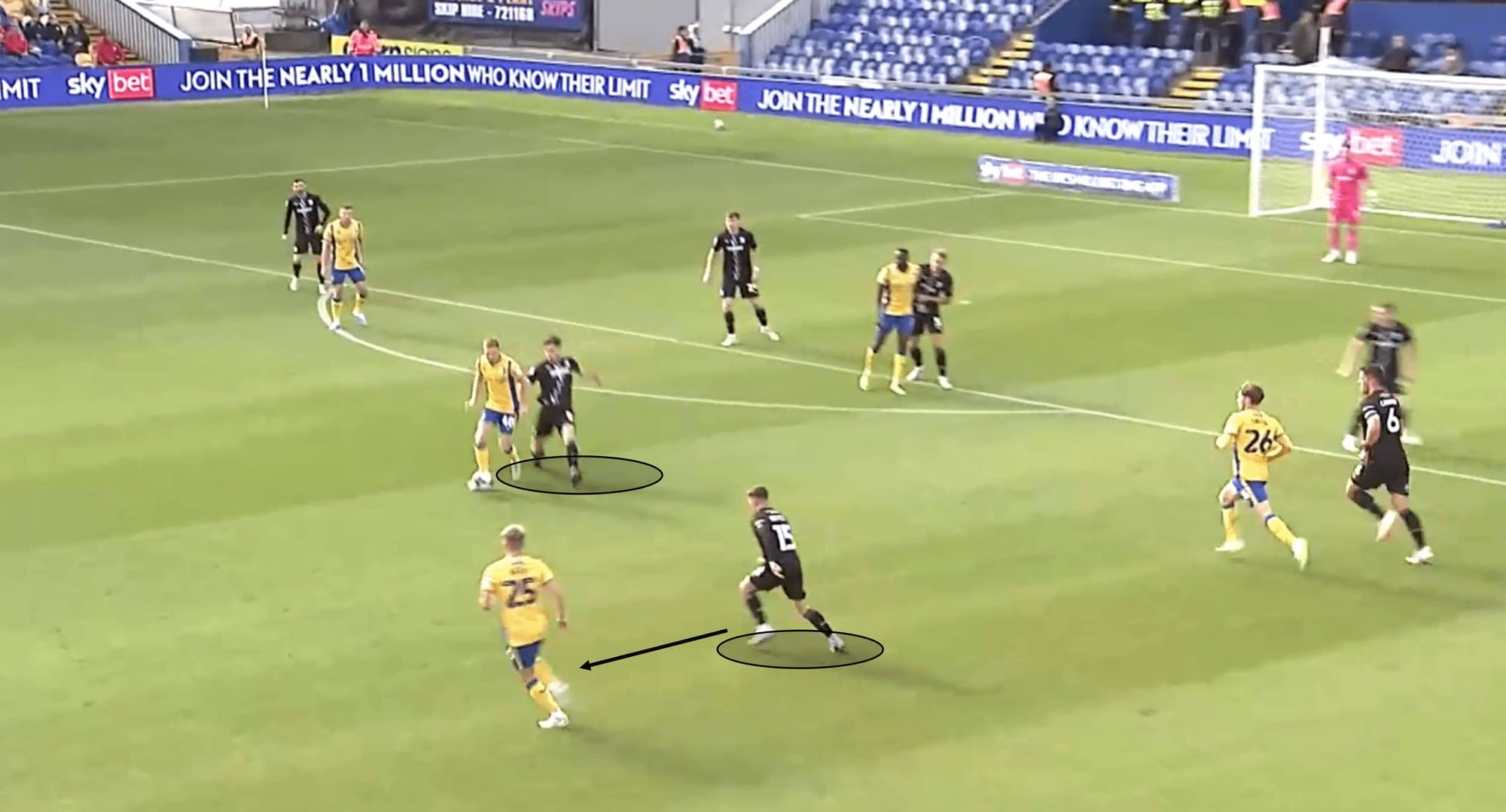
When defending deeper with the opposition’s higher presence up the field, Barrow’s midfield is likely to sit deeper, even close to the back five.
This is to protect the defenders in the centre and force the opposition out wide, as Barrow is confident in defending the box with more bodies and some good height, too.
While deep and defensively engaged, we still see a level of aggression from at least one of the midfielders, as they don’t want to allow the opponent time and space in the middle.
Teammates close by, including other midfielders, will mark close opposition passing options while the three of them carry out these individual roles while also ensuring the unit’s defensive integrity.
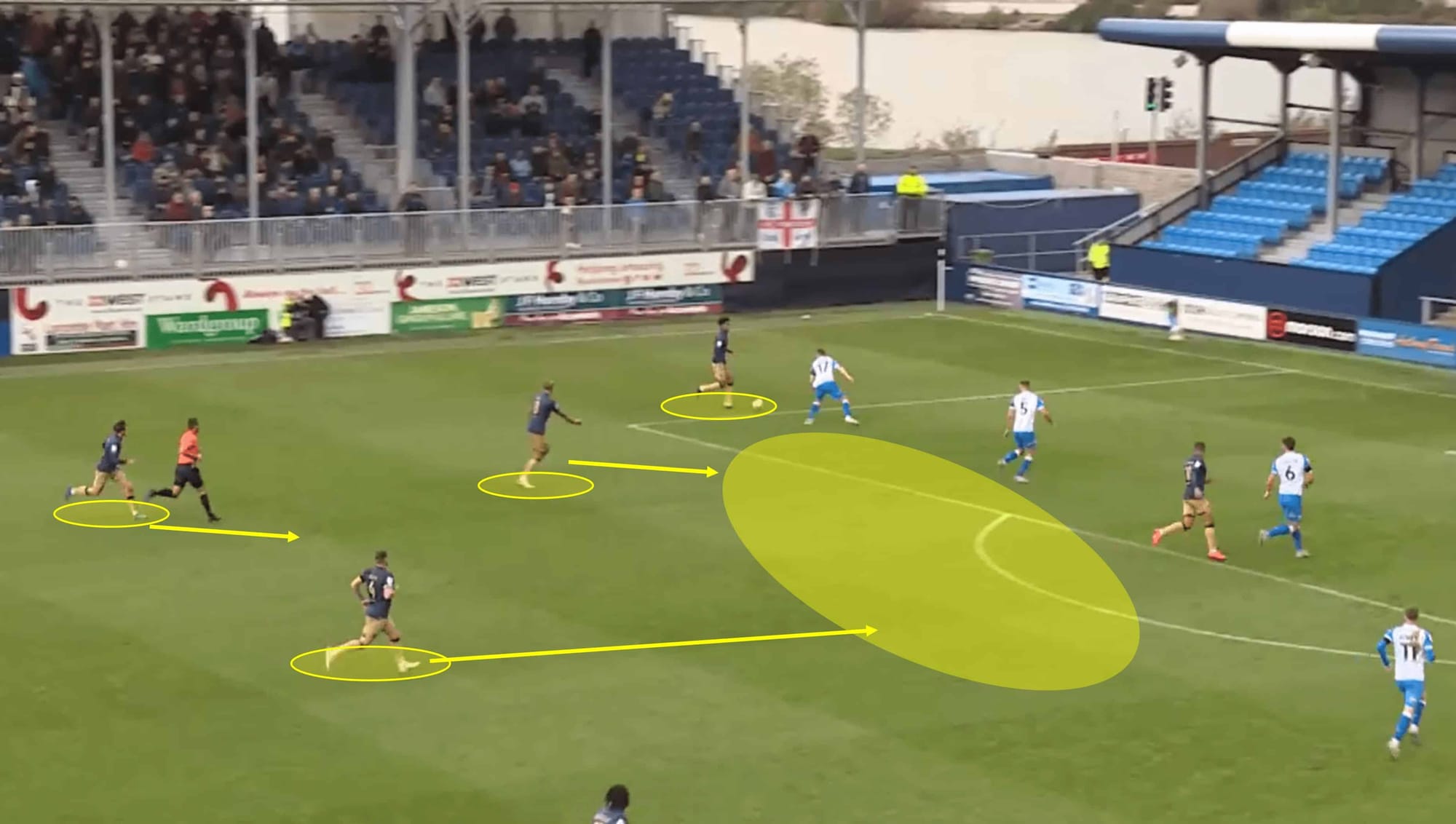
One thing they have had some trouble with is their ability to defend transitions that occur higher up the pitch.
When the opponent regains possession in a higher position, with more players present in more dangerous areas, Barrow’s defensive priority is, understandably, the penalty area and marking the attackers.
However, the example above, like most counterattacks, involves late runs from midfielders – mainly runs towards the edge of the box after the Barrow defence has arrived inside the box.
Now, if Barrow is lucky, they are sometimes equipped with midfielders already in position here, but there have been multiple instances that mirror the one above—a downfall that could really haunt them later in the season if they don’t find a way to plug that gap.
Lack of goalscoring prowess
Last season, despite finishing ninth in what was a brilliant season for the club, Barrow only netted 47 times in the league – one of the lowest tallies in the entire division, so it appears that struggling to find an edge in front of goal is not a fresh issue for Wild.
This final segment provides some data and match stills as we look to uncover some of their issues in front of the goal. It will also analyze some of the positive elements of their attacking play.
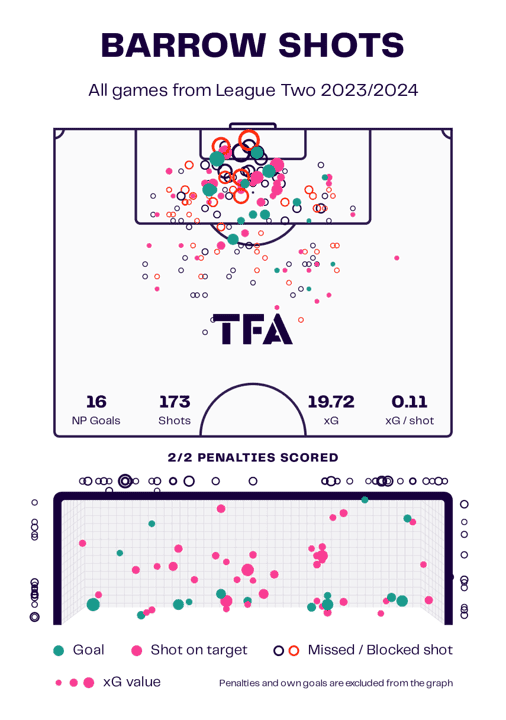
We begin this segment of analysis by taking an overview look at their goalscoring output.
Just 16 non-penalty goals may give you the initial idea that they don’t play with much promise or identity, but that is not the case.
Their troubles in front of goal stem from inconsistency in the end product – a lack of ability to deliver a quality final ball when called upon is hurting them as their build-up play holds some real strengths.
There is also an argument that the chances need to be finished off with a more clinical edge—they are currently underperforming their xG, which indicates they should be scoring more based on the chances they create.
That xG currently stands at 21.24, which is far too low for a team looking to build on last season’s ninth finish.
They also have the second-lowest shots on target rate, hitting the target with just 32.6% of their shots.
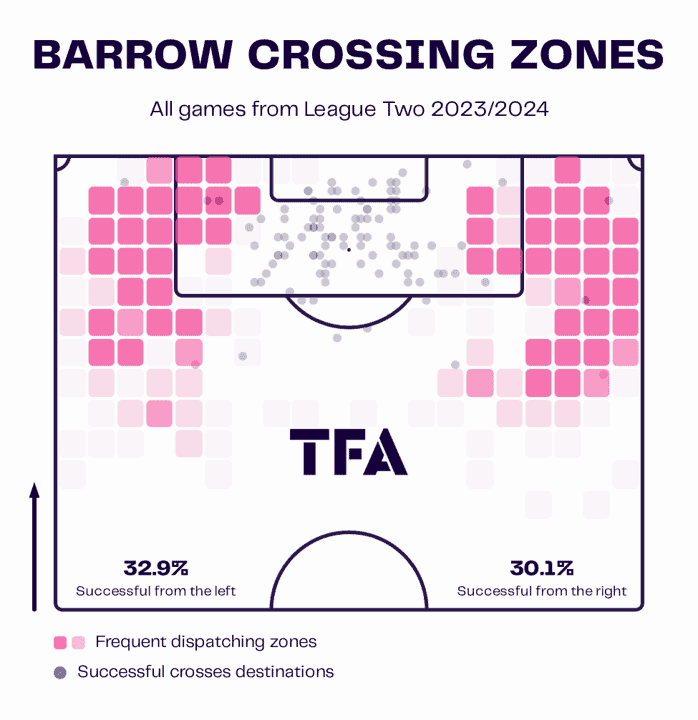
At the time of writing, Barrow averages 18.49 crossing attempts per 90 (fourth-highest in the league), so it seems to be a clear tactical element of their attacking play.
However, their low accuracy rate of 31.5% (fourth-lowest in the division) suggests they’re having some real issues with it.
This could be due to one of two main factors: the quality of the cross or the movement/positioning of those in the box to get on the end of the delivery.
Regardless, if they insist on sticking to these tactics, they need some tweaking to get the most out of them.
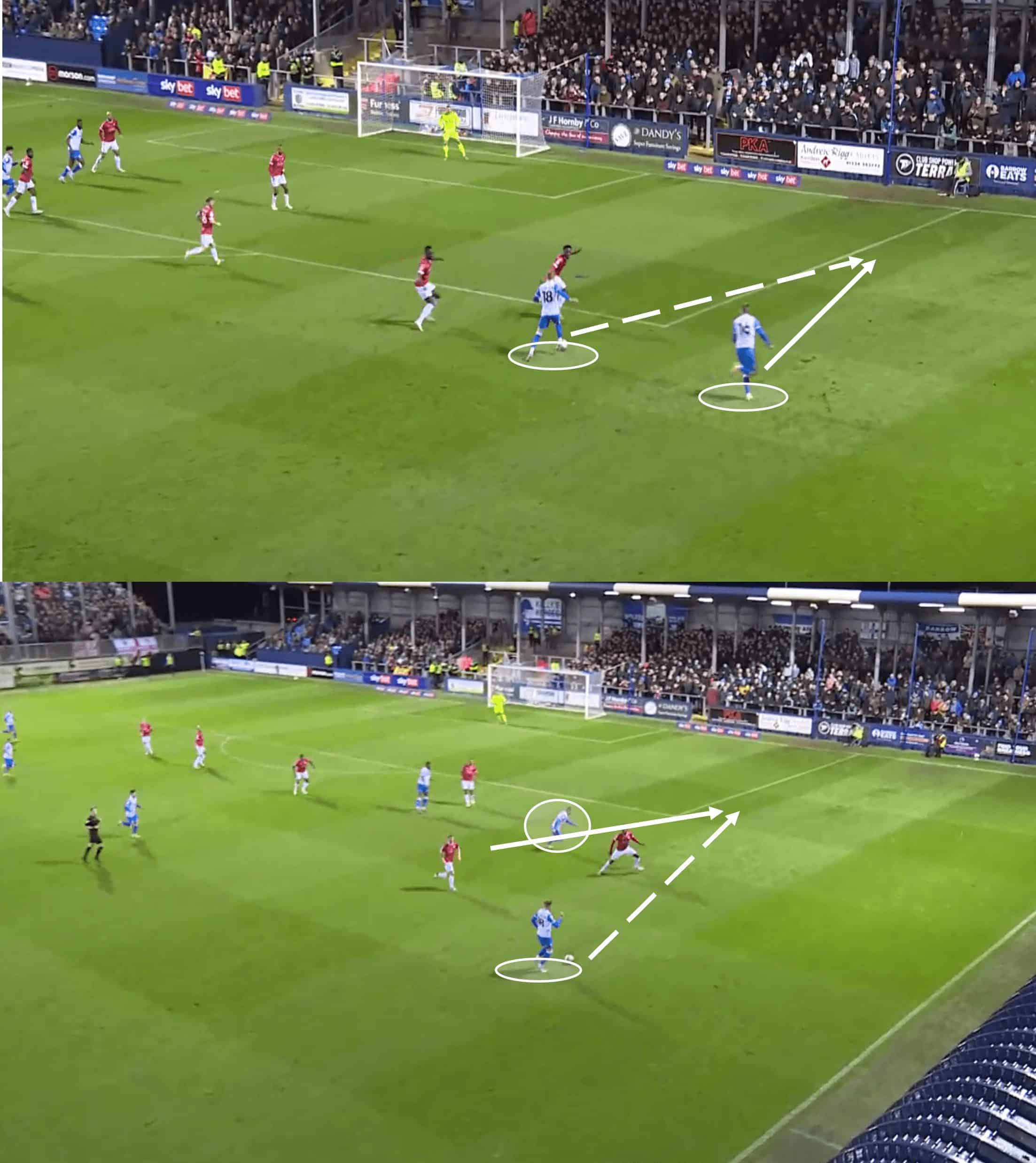
Playing without genuine wingers in a 5-3-2 can present some challenges in terms of attacking, especially attacking wide areas.
But this is an area of strength for Barrow, one that highlights real team cohesion and tactical understanding.
While the wing-backs do get forward on occasion, many of their attacking moves involve either an overlapping/underlapping run, usually from the closest midfielder, into the channel behind the opposition full-back.
This requires good timing from both the runner and the passer.
It allows Barrow to get towards the box while getting in behind an opposition defender, so pass execution is vital.
The Bluebirds have the sixth-highest average for passes into the final third and the fourth-highest accuracy rate, so they have no issue getting into dangerous areas in attack.
Again, though, there is an issue in what happens once the runner receives the ball.
Poor delivery quality seems to be the main culprit in these areas, but it is not the only reason Barrow isn’t as dangerous as it should be.
They average 17.47 touches in the box per 90, which is the eighth-highest average in the league currently.
This is evidence that they do get the ball into teammates inside the box; the question remains around the quality of chance the attackers in the box have.
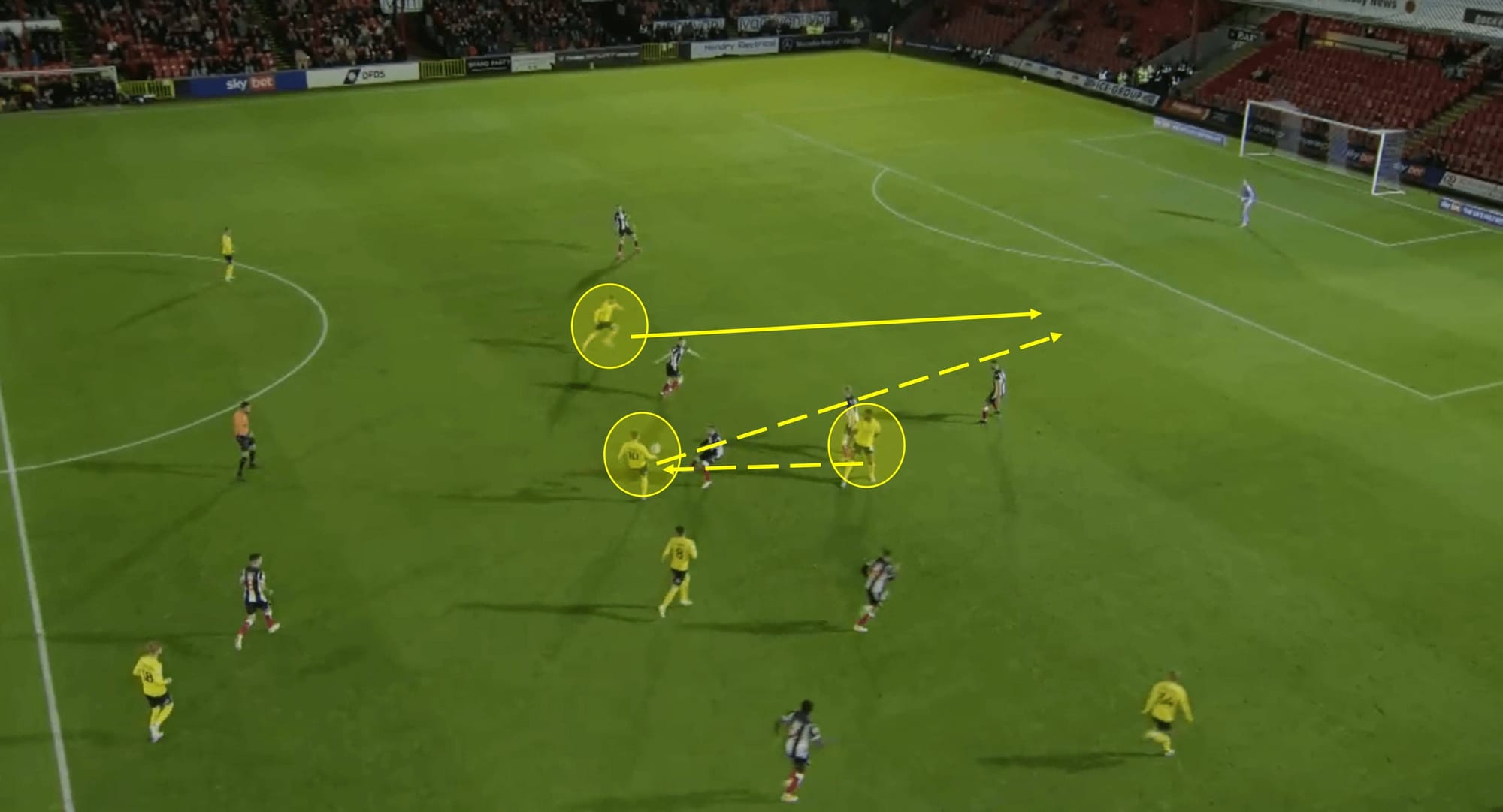
Another critical part of their attacking tactics is similar to the previous discussion: the use of runners.
This time, however, we’re talking about runners from midfield into central areas rather than as a tool to support/link up with the wing-back.
A standard part of Wild’s attack is to bring one (or both) of the CFs into the build-up play as part of a passing combination, with a midfielder launching a bursting run ahead of his teammates.
Now, the location of this series of actions differs.
Above, the location means that the runner is going through on goal, but they have also been seen to use runs from midfield against a deep defence.
The use of long passes is sometimes crucial in Barrow’s mission to get the ball forward quickly
—they average 54.66 long passes per 90 (just above the league average), which comes with an accuracy rate of 57.7%—the joint-highest rate in the league, so they clearly use the tool to good effect.
It will come as no surprise that Barrow is also effective at executing progressive passes—they have the fifth-highest attempt average and the third-highest accurate rate.
Conclusion
Again, touching back on their issues in the final third, their output is a worry.
Just 9.8 shots per 90 (below league average) is not enough and tells you a lot about their attacking struggles – their shot accuracy rate of 32.6% is the second lowest in the league, so there is an apparent problem at the end of their play.
Whether their low attacking output derails their season remains to be seen, but it may not matter too much if they can maintain their strong defensive performance – they wouldn’t be the first team to reach the playoffs with a low-scoring team.
And while the playoff may still be a long shot for Barrow this season under Pete Wild’s coaching style, the element of being difficult to beat will provide hope for the fans.

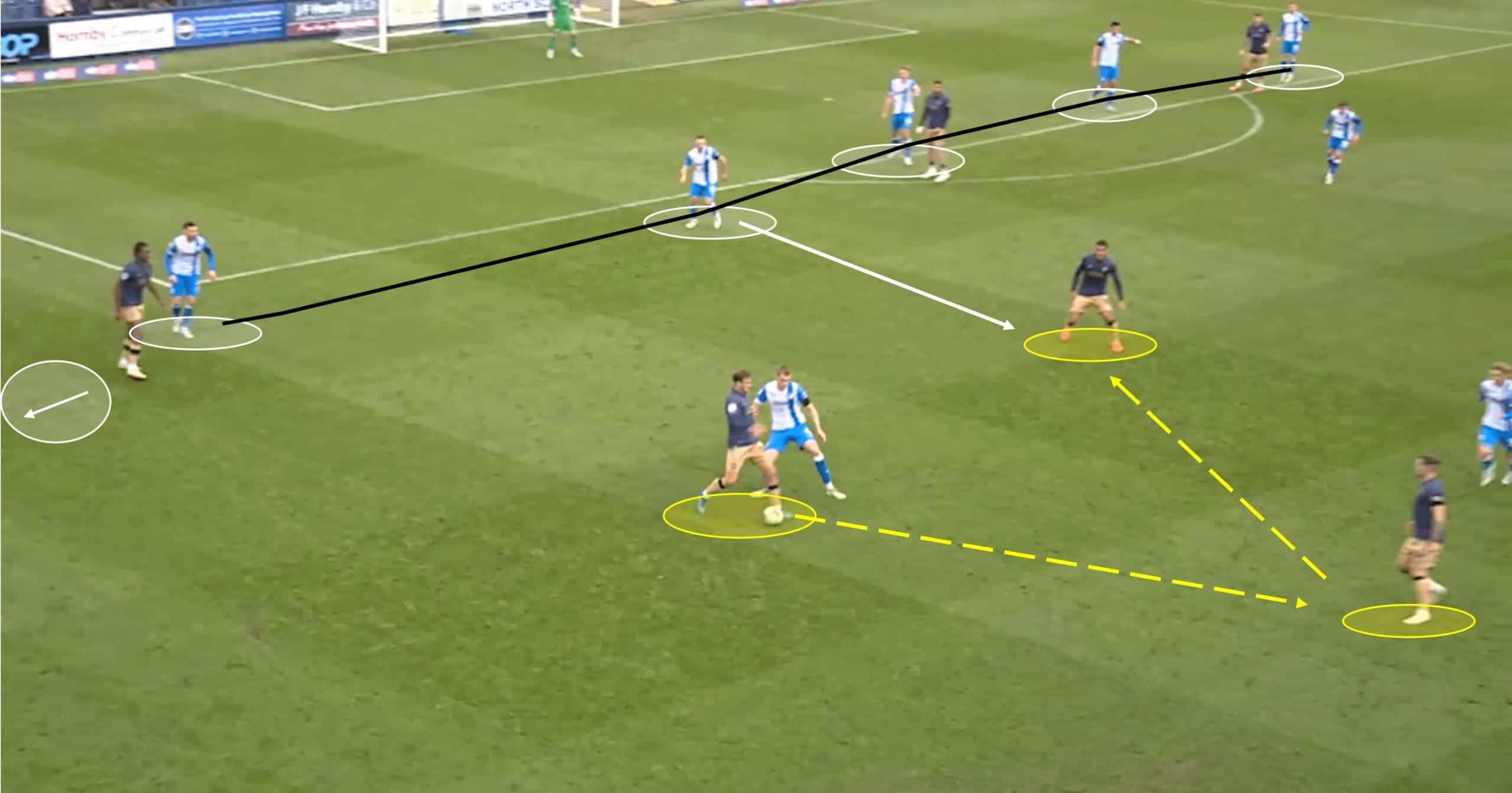




Comments